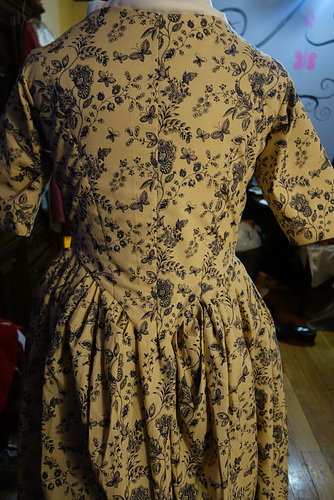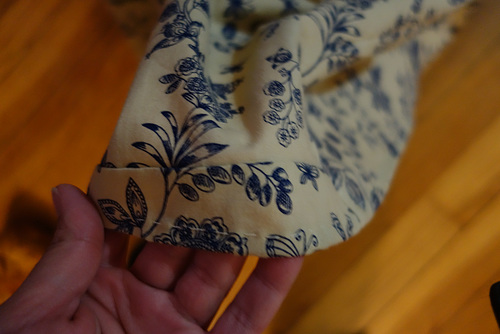Saturday, April 25, 2015
New Zone Front Dress
So the last photo is showing where I had to piece the skirt together for this Zone Front style dress because, unfortuantely, I didn't have quite enough fabric.
The full story: The amazing thrift store I go to had this blue and cream cotton for $3.90 for the entire length of it. It ended up being roughly 3 yards although it was hard to tell because it was someone's remnant and they had cut what looked like another dress out of it. I knew I had enough fabric to eek out a dress if I tried.
I used the Pegee of Williamsburg anglaise pattern as a base and worked out from there. I made the back into three piece (center back, two side backs) and had the center back still attached to the skirt back. I used my own sleeve pattern - the same one I created last year for my 18th Century jacket. The front of the pattern I cut out normally for the blue silk satin stomacher part and I flipped it up to created the angle for the zone front out of the cotton.
The bodice is lined in linen but the sleeves are lined in a stripped cotton (which you can see a bit because of the elbow flap).
While sewing the dress, I decided to come up with a new term - Visually accurate. Basically visually accurate pieces are ones that fall into the old SCA 10 foot rule - if it looks accurate from 10 feet away, it's good. It differs from historically accurate as you might be using a sewing machine or the fabric isn't exactly correct for that time period (who doesn't use silk dupioni?) or something else of that nature. If someone of the time period saw you from 10 feet away (sightly over 3 meters away) and wouldn't bat an eyelash about what you were wearing - ie, it would look normal from that distance to them- then it's visually accurate.
I did a lot of the interior seams of this dress on the machine. However, any visible seams (ie, the hem!) are hand sewn. Really, the only things machine sewn are the sleeves, the side skirt seams, the front line of the bodice and...that's it. The back seams? I sewed them using a historical method. I used cotton thread on the cotton dress - the pattern is accurate for the last quarter of the 18th century. Because I used the sewing machine, I'm calling this highly visually accurate.
The petticoat is another matter. It was once a bedspread. I cut a pocket slit, bound that with purple bias tape, cut out the batting from the top 2" of the petticoat, pleated it, attached silk waistbands to the front and back and...instant quilted petticoat! The hem was already bound because it had been the edge of the bedspread. This is more necessary garb low visually accurate. The lavender went well with the blue (much better than the orange!) but none of the materials are accurate. They did have quilted petticoats in the 18th century just not out of poly satin. ;-)
Overally, I'm happy with the dress. I'm going to add buttons down the front - I bought bone roundels to make fabric buttons for the dress. I just didn't have the time yesterday nor the proper materials to make them. I think the petticoat might need some work though. I pleated it wrong- not a big deal for today since both the dress and the cape hid anything. I also don't like the ties I cut out four months ago for it (did I mention the petticoat was a UFO...for the past two years?).
Labels:
18th century,
costuming,
dress,
sewing
Subscribe to:
Post Comments (Atom)





0 comments:
Post a Comment